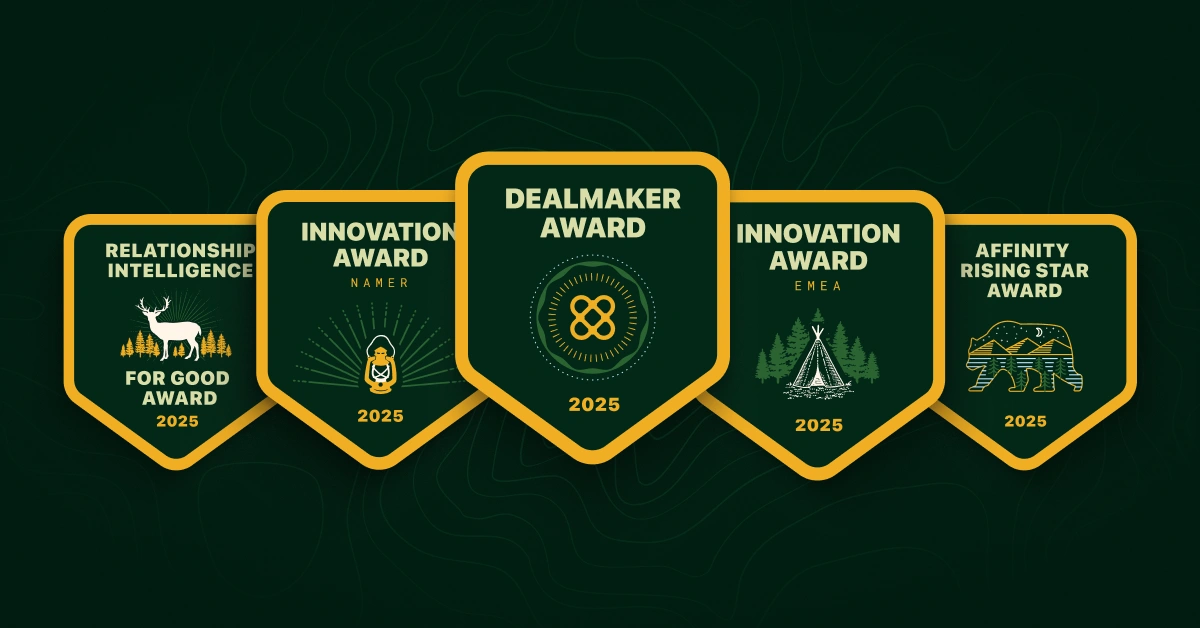Originally published for Forbes Technology Council
As CEO of Affinity, Ray’s goal is to bring relationship intelligence to the world because every opportunity begins with a relationship.
Venture capital, private equity, consulting, and investment banking are some of the most hyperconnected industries in the world.
To maintain their connections, dealmakers endure a steady bombardment of relationship-related noise: from not-so-interesting threads on LinkedIn, Facebook, and Twitter; in InMails, Slack channels, and webinar invitations; even during group Zoom meetings where the topic is only of tangential interest.
These same professionals have the biggest business networks, take the most meetings, maintain the most relationships, and spend the most time in their email and calendars: in other words, they have the most to keep track of and the least amount of time to track it.
So they turn to imperfect, manual systems—packaged technology or self-invented—to help them. And they’re left to filter all that collateral noise and jam only the relevant bits into spreadsheets, or enterprise-wide customer relationship management (CRM) platforms, or the Notes app on their iPhones—maybe even onto legal pads in their top desk drawer.
Learn more about how leading investors are looking beyond traditional CRMs
Whatever their medium of choice, this relationship data entry has to be done manually, which takes time away from building and growing their network.
Capturing and interpreting relationship data
Is the first thing you do after a business meeting enter notes and details in a database?
Me neither.
Usually, after that meeting, I take another meeting. So all the data noise never gets filtered, or the data that is valuable is lost. When you do remember to record details, if they’re inaccurate or incomplete then the data gets polluted fast. The reservoir is only as pure as what’s flowing into it. Put less elegantly: garbage in, garbage out.
But even if you could capture the relevant relationship data automatically, all you’d have is a novelly assembled digital address book. Automation is only the start. The most valuable information—who knows whom, what a colleague met with a prospect about, data about recent fundings or investments or consulting engagements—remains in stasis, ready to be interpreted but locked in silos that can’t be shared. Or it’s drowned out by the background noise of a super-connected industry.
An ideal intelligent relationship management system would go one step further than automation: it would monitor and analyze information to provide incisive insights—how much money a company is raising, when their next funding round will be, if your relationship with them is waning and it’s time to reach out, or if they’re primed for an acquisition or sale.
Exhaust ecology
Each of us generates oceans of data “exhaust.” Think of it not as pollution but as the fertile byproduct of green energy production: information that is valuable, and that traps insights we need but we’re unaware of. It remains undiscovered, and we let it evaporate into the ether.
{{ib-guide-crm="/rt-components"}}
Your team’s data exhaust—contact and activity information stored in emails, calendar invites, and meeting notes that are often overlooked and discarded—is an invaluable source of relationship intelligence that lets you more easily manage your business relationships. It’s this exhaust data that actually forms the most accurate map of your business network. But capturing it is not so easy.
The source of relationship intelligence
The promise of computing, made way back in the Eniac days, has always been that it would free humans from the drudgery of repetitive tasks and provide answers and insights more efficiently than a person ever could. And in many ways, that promise has been kept.
But in other ways, the covenant has been broken. It’s axiomatic that people work for their computers as much as their computers work for them. Add rigid engineering, poorly designed user interfaces, and laggard technologies—like last-generation CRMs—and you wind up not just working harder but taking instructions from a digital factory foreman about exactly how to do your work.
Beyond preserving a cloud of data exhaust, a useful relationship management platform is industry-specific and works the way you do. It captures and extracts a comprehensive, accurate set of contact information about each contact, analyzes it, and proactively unveils insights that help users make smarter business decisions. That’s the intelligence part of relationship intelligence.
It’s who you know—and what you know about them
Once upon a time, sending cold, customized(ish) emails and InMails to a targeted audience was novel. That world is, or should be, in your rearview mirror.
It’s always been about whom you know—the relationships you’ve built, the ones you’re building, and the ones you ought to be pursuing. The trick is finding technology that can identify where in your business network the opportunities are hiding, because those relationships are an asset in which you’re forever investing.
Today’s relationship intelligence platforms—a new breed of customer relationship management software that not only captures data automatically but interprets that data in ways specific to your industry and to your own firm—are just the start.
Relationship intelligence and the CRM of the future
How do you aggregate and sync the data exhaust about all the relationships in the world and use that data to continuously generate insights for users of any kind to help them make better decisions about anything and everything? Or find new ways of combining simple data points to describe the intricacies of human relationships?
The information might be assembled via thought-driven smart devices or synthesized in real time by machine learning from intra-company correspondence or The New York Times archives. It could be displayed in augmented reality goggles or on the dashboards of self-driving cars. And it would be contextualized within the tools and platforms that people use daily.
{{ib-guide-crm-2="/rt-components"}}
Augmented reality glasses are not yet must-have business gadgets. For now, we use browsers and mobile apps to access emails and PitchBook, or we use smartphones to send texts and check our calendars and read The Wall Street Journal.
Future generations of relationship intelligence platforms will be wholly agnostic to the communication platforms and data sources they’re linking to and gleaning from. But as long as relationships are the backbone of the world economy—and the most valuable asset every professional possesses—the need for relationship intelligence will remain paramount.
Learn how leading investors are getting ahead with relationship intelligence.







.png)


.webp)
.webp)
